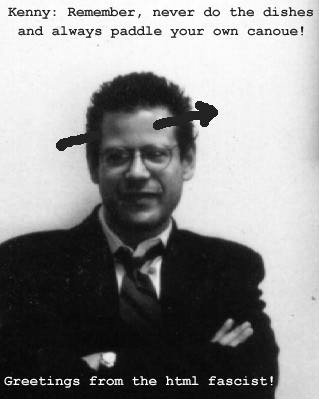Ben Kinmont
We Both Belong
Internet project for Adaweb
http://adaweb.com/adaweb/influx/kinmont/bk1.html
Ben Kinmont @ adaweb.com/adaweb/kinmont/blah/blah/blah
If Duchamp were with us today, he'd jump up in his Nikes and proclaim: "I am not a role model". Perhaps as early as 1910 D. had the notion that anything could be art. Perhaps people like John Armleder, Hiam Steinbach, Jeff Koons, Damien Hirst and countless others were just not paying attention. (See Nauman print, titled: "Pay Attention Mother Fuckers") In any event, as a strategy, the idea of using preexisting objects as a time-saving ploy to make conceptual art, in order to make extra time for dinner and drinks at Odeon, is tired and stale. So, the mavens of art as idea have come up with a new set of clothes for the emperor. As society shifted from an emphasis on the manufacturing of hard commodities to a service oriented economy; and, subsequently to a world driven by the creation and dissemination of information and technology, the readymade has reappeared in yet a new guise. Yes, new and improved methods of artistic production have arisen to meet and elucidate the burdens of our time. Services, information, and technology -- as is, as art. For an example in the former category, we have one of the brilliantly brilliant British artists, Michael Landy, ready, willing and able to pick up your trash for you, for society at large. What a guy, what a piece of...art. In the realm of information as object, there is the tireless, hyper-paranoid gatherer of covert data, Peter Fend and his "news room" projects. He is at the ready to make you a commission (for lots of unmarked hard currency) based on your heritage, if the CIA hasn't closed in and captured him yet. And, last but not least, the vast virgin field of information content; and, that infinite horizon we know as the internet. An example of a purveyor on the net in the name of alleged art is none other than cyberpreneur Wolfgang Staehle himself, and his baby, "thing". I'm afraid its true, the html-fascist ran out of tv commercials to appropriate for his video clip pieces, and his dealer nailed his doors shut to become a gentleman-farmer in a far-off land. So, Mr. Staehle began tinkering with pc's, and for lack of a better term; or, in order not to alienate his European dealers and collectors, calls it art.
Ben Kinmont's adaweb project, entitled "We Both Belong", sounds like a new age, self-help guide to the internet. In the category of a service equaling a piece of sculpture (he said it, not me), Kinmont attempts to posit that washing dishes is akin to a piece of art. Coupled with the trash hauling Brit, we are well on our way to a cleaner more beautiful land, all in the name of art. Using the buzz words of the crystal carrying new-agers like "shared space", "means of empowerment", and "domestic action", Kinmont, in an act of chimera, is under the impression that a little house cleaning goes a long way. It goes like this: he did his, now you do yours. Respond by e-mail, then send in a photo of yourself doing the dirty (I mean cleaning pots and pans!). Later, in the real world, Kinmont will exhibit little diptychs of the both of you bent over the sink, and thereafter, you will receive the piece for your troubles. Dream on. I imagine his most receptive audience, as well as his most encouraging fan, is his wife. Not that I mean to belittle this inventive use of ada's wavelengths, for I myself have e-mailed a response to the query, though I have yet to follow up with a photo (nor have 34 of the 40 who have thus far participated). In the end, who am I to suggest that everything isn't art? If I find the vacuum, mop, fantastic, paper towels, use em, then shower, I have enough domestic action for a retrospective.
-Kenny Schachter
To post a response fill out the following form and click the "Submit" button. Or go back...
Scroll down to read responses.


